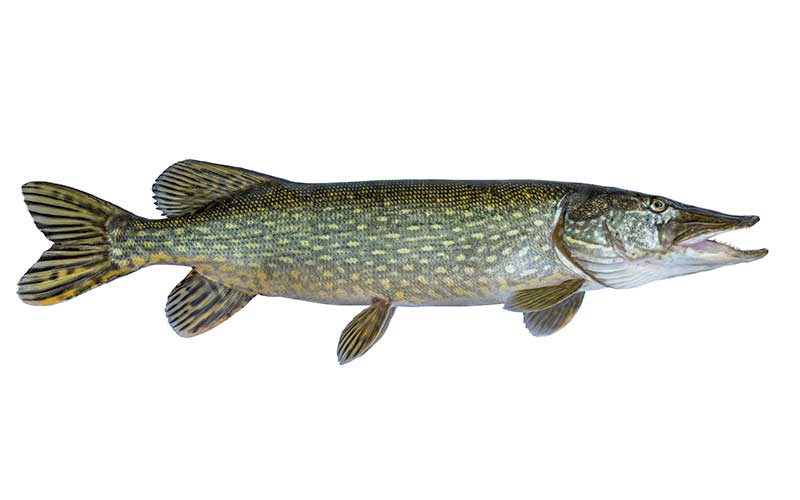What’s the Catch?
Guidelines / Tips / Fish Species / Catch & Release

Walleye
Are you a Walleye snob? Many, many guests choose to target this species exclusively—and why not? They are abundant and offer end-to-end action. Walleye is one of the tastiest fish you can catch. The Walleye in the tea-coloured bog-fed lakes of the Canadian Shield are a dark green to gold colour. They prefer drop-offs and reef edges, and can be found at the edges of fast-moving water like river inlets and outlets. They will typically move to deeper water as the summer progresses and warms up, and then come back to shallower waters in the fall. It’s very common for guests to land a Master Angler Walleye at Harrop—that’s 28 inches and bigger with a few every year stretching to the 30s mark. Vertical jigging with slow-moving 3/8 or 1/4 ounce jigs is the preferred method. Spinners and bottom bouncers, as well as crank baits like a Rapala tail dancer or Hot n Tot’s, are other excellent choices.

Northern Pike
So, you want a fight you say? Well, hold on! We have just the ticket! One of the most exciting fish you can latch onto is a Northern Pike. Northern Pike at both Harrop and Whiskeyjack grow to extraordinary sizes. Every year we have a few in the 50-inch-plus range with many Masters 41 inch+ being landed. That’s a 20+ pound fish! Talk about making your drag scream and your adrenaline run. Pike are our most vicious predators lurking in the water. Pike favour heavily vegetated areas, but will move into your favourite Walleye hole to feed on those same Walleye, so be ready for a fight. Pike prefer a larger bait presentation, but many anglers have told us they were fighting a good-sized Walleye at their favourite Walleye spot when all of a sudden their drag exploded and a BIG Northern Pike T-boned their Walleye and they netted both. Black and silver, as well as blue and silver crank baits such as a Rapala, work well for those big Pike.
Other Species
We also have a resident population of Saugers, Yellow Perch, Mooneye and Whitefish. You can never be quite sure what is going to latch on when you toss a jig into the water.
Catch & Release Tips
These methods will ensure a successful release to be caught another day:
- Play your fish as little possible.
- Take pictures as quickly as possible.
- Return fish to the water as soon as possible.
- Don’t hold fish by the gills or eyes or use gaffs.
- Don’t squeeze the fish or allow it to flop all over the boat.

Barbless Hooks
Manitoba fishing regulations require the use of barbless hooks when fishing in Manitoba waters. All hooks attached to your fishing line must have no barb OR the barb must be pinched against the shaft of the hook. You are allowed to keep barbed hooks in your tackle box.
Why barbless hooks? They allow for easier removal of your catch. When there is less stress on the fish, there’s a better chance they’ll survive when returned to the water.
Handling Fish
When practicing catch and release, the way fish are handled is extremely important.
- Never insert your hands/fingers into the gills.
- To hold a fish, carefully place your hands under its belly.
- Pull fish from the water under the jaw bone.
- Want photos? Using gloves, place one hand in front of the fish’s tail and the other under the fish’s belly.
- RELEASE: Do not throw fish back into the water. To return a fish to the water, hold it by its tail. Slowly move the fish from side to side (“S” pattern) until it recovers its strength and swims away. Do not pull towards you or push away.
- Sometimes when a fish is caught, the hook will be lodged in the fish’s throat. Do not forcefully pull on the hook to remove it as this can result in excessive bleeding or even death. If you can’t carefully remove the hook, it’s best to just cut the line at the hook. The fish’s digestive enzymes will corrode the hook and it will eventually work its way out.